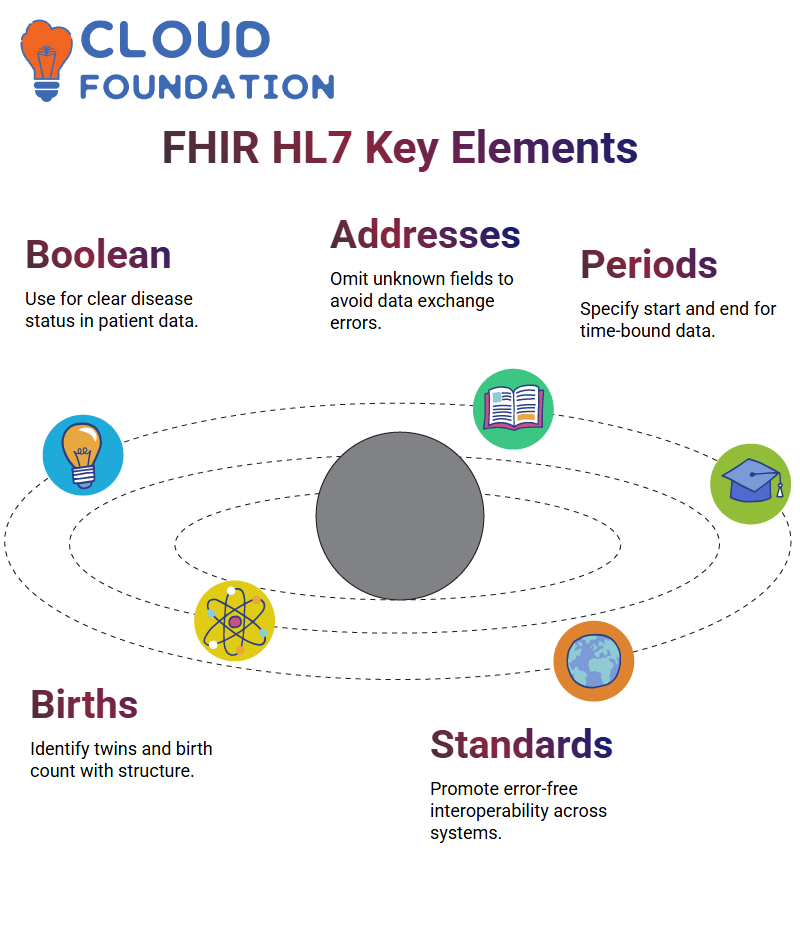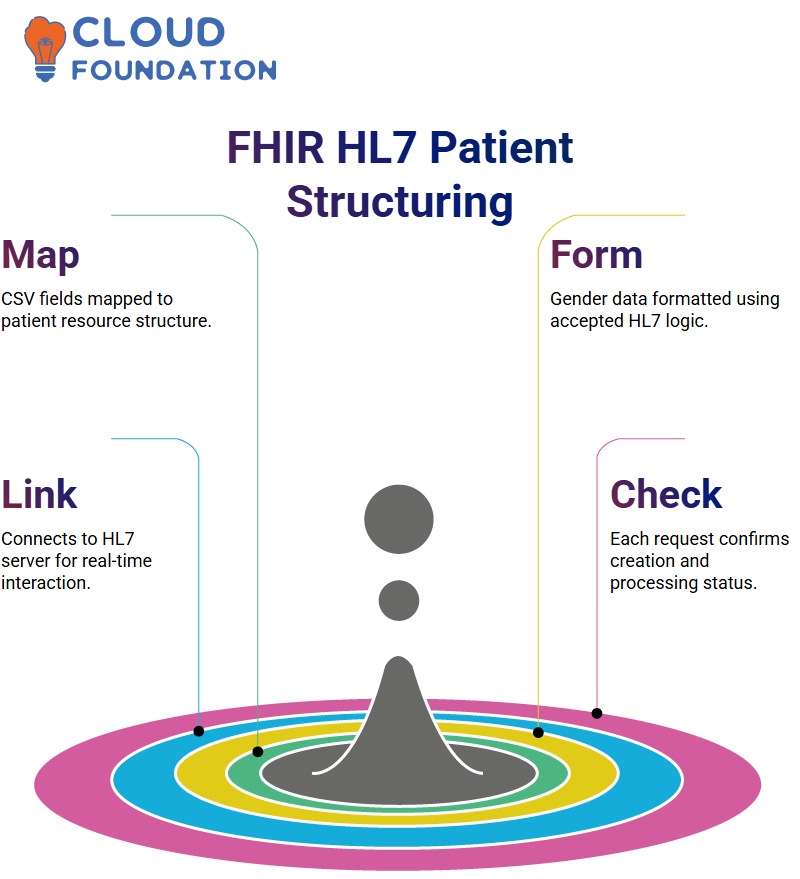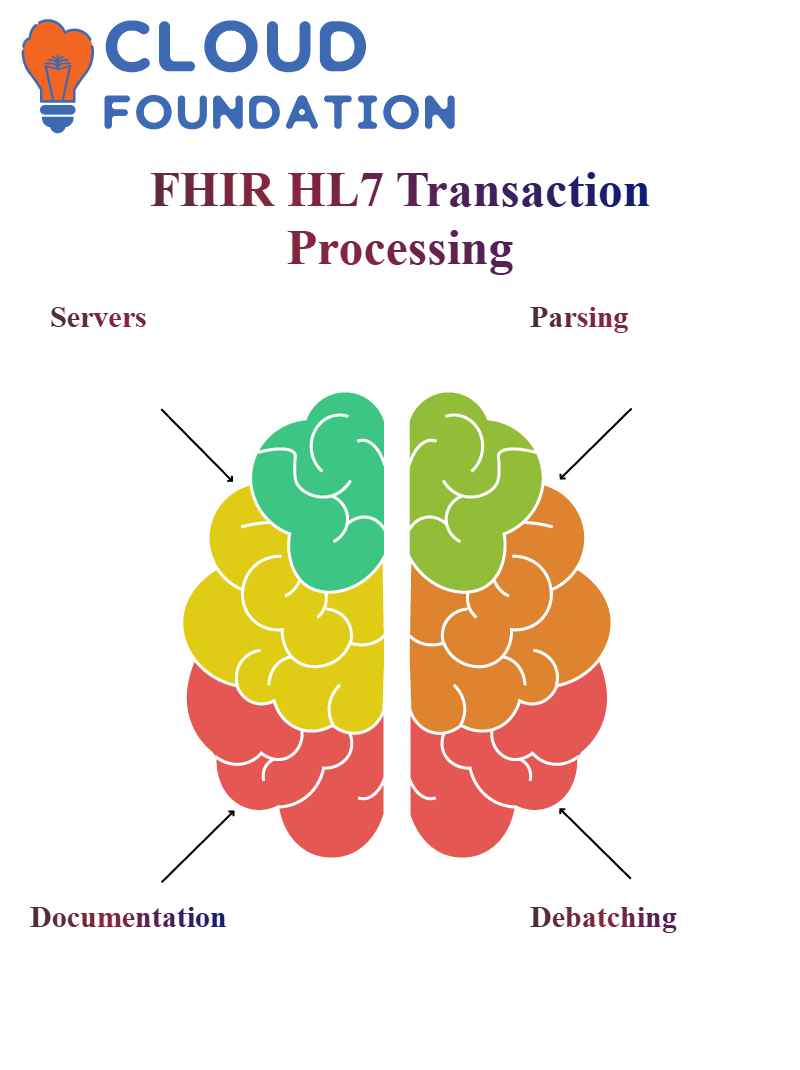FHIR HL7 Implementation Training
FHIR HL7:
FHIR HL7 is an essential framework in healthcare data exchange. I’ve spent much of my time exploring its intricate details, and one concept that stands out is the concept of codable data types.
When working with codable concept data types, ensure that I extend codes from predefined value sets; this is essential when working within FHIR and HL7.
FHIR HL7 requires an understanding of both code and system definitions to function optimally.
When navigating identity type attributes, I always refer to value sets to identify predetermined values for any identity type attributes that require predetermined values.
When selecting medical record numbers, I analyse both their system definition and code definition to ensure an accurate representation.
The system plays an essential role in differentiating identical identifiers across organisations; for instance, two employees sharing identical IDs may each utilise their organisation-specific system to ensure clarity.

FHIR HL7 requires assigning unique URI-based systems as a means to establish unique identification standards.
FHIR HL7 requires compliance with structured contract principles within integration layers to ensure data flows efficiently across healthcare systems while remaining consistent.
I always ensure that my layers align with predetermined data mapping standards to maximise data efficiency.
My experience in FHIR HL7 has demonstrated how structured repositories improve data validation. Maintaining accurate records and integrating databases and layers is of utmost importance.
I collaborate closely with applications that implement standard repositories within FHIR HL7 contexts.
FHIR HL7 provides universal standards that healthcare providers must abide by. By adhering to proper system definition and value sets, I help maintain data integrity across different platforms.
Applying FHIR HL7 in real-world situations requires meticulous structuring of data attributes. I regularly assess system, code, and display properties against industry best practices to create successful solutions for clients.
Things to Understand in FHIR HL7:
FHIR HL7 provides an adaptable framework that enables implementers to select the data type that best meets their requirements. For instance, a healthcare app collecting disease status may opt for Boolean values to ensure accurate patient records and precise documentation.
FHIR HL7 addresses are another essential element. When specific details are unavailable, best practices recommend eliminating those attributes rather than leaving them blank – this ensures an efficient data exchange environment without errors and inaccuracies.
 FHIR HL7’s period management feature is also remarkable: imagine an address is only valid for six months — FHIR HL7 allows specifying both start and end dates to ensure data retention and access at optimal levels.
FHIR HL7’s period management feature is also remarkable: imagine an address is only valid for six months — FHIR HL7 allows specifying both start and end dates to ensure data retention and access at optimal levels.
FHIR HL7 also provides for intelligently structured multiple birth attributes. From Boolean attributes that identify twins to integer-based specifications of various births, every element has been carefully considered with precision in mind.
FHIR, an extension of HL7, ensures healthcare applications communicate efficiently by mandating structured data representations that reduce errors while optimising interoperability. Adherence to FHIR HL7 standards minimises errors while increasing interoperability between applications.
FHIR HL7 for Efficient Data Management
FHIR HL7 extends beyond names in its data organisation process; our telecom section enables users to designate phone numbers as either home or work types, establishing efficient communication channels between providers and patients. FHIR HL7 simplifies this by employing structured cardinality checks and data validation procedures.
FHIR HL7 operates via established standards that define JSON formatting principles to guarantee structured data transfer. FHIR HL7 plays a crucial role in understanding rank allocation within telecom structures.
FHIR HL7’s strength lies in its handling of positive integer values in data fields. Following JSON principles, integer values can be directly entered without quotation marks, ensuring data consistency across applications.
FHIR HL7 has become an indispensable element of modern healthcare data management. Whether structuring patient names, telecom attributes, or rank definitions, FHIR HL7 ensures clarity, usability, and seamless integration; every component within JSON structures adheres to its comprehensive framework.
FHIR HL7 fosters efficiency in healthcare applications by streamlining data mapping processes. By adhering to predetermined rules, developers ensure seamless interactions across platforms.
Furthermore, its adaptable nature enhances interoperability, making FHIR HL7 an industry standard that should not be disregarded.
FHIR HL7 stands as the industry standard for healthcare interoperability; its principles ensure accurate data representation for seamless transitions in digital healthcare records. Organisations that rely on it can take advantage of standard data formatting.
FHIR HL7 provides healthcare IT solutions with structure. From configuring patient records and refining JSON data to configuring patient profiles or refining JSON, FHIR HL7’s rules ensure consistency for optimal data precision—an added advantage for developers using it as part of healthcare IT solutions.
FHIR HL7 helps organisations meet interoperability objectives with its robust framework, ensuring the accurate handling of telecom attributes and prioritisation of ranks. Healthcare IT platforms utilising FHIR HL7 can experience smooth data processing.
Mapper for FHIR HL7 Data Transformation
Mappers are powerful tools, and when combined, can transform anything from an HL7 message or an XML document to fit within any standard protocol (HL7v2 typically) into the output desired – but customisation options do exist should you require any other result than this standard output format.

FHIR HL7 schema-based mapping makes data manipulation simpler with drag-and-drop functions for manipulating structured information.
FHIR HL7 Schema-Based Mapping Process
Rhapsody makes mapping easy with its schema-driven approach, allowing you to drag and drop and apply parsing logic, such as conditionals, loops, and strict parsing methods.
Schema-Based Mapping for FHIR HL7 Patient Resources
FHIR HL7 patient resources provide detailed schemas that can be leveraged within Rhapsody’s mapper interface for easy use in creating structures and generating output. Once loaded, user-friendly instructions guide the creation of structures.
Understanding schema mappings ensures efficient FHIR/HL7 interoperability when working with bundle resources or individual patient records.
Mapping Patient Resources in FHIR HL7
FHIR HL7 provides powerful drag-and-drop tools, simplifying the mapping of identifiers. When working with bundles (essentially groups of resources), understanding iteration functions is vitally important.

With FHIR HL7’s iteration engine in place, most iteration processes take care of themselves, eliminating the need for complex brackets or syntax complexity to be an issue for users.
FHIR HL7 Identifiers and System Mapping
Mapping patient identifiers in FHIR HL7 is straightforward. From official identifications to system-generated values, defining attributes is key in mapping them effectively.
You can specify an identifier within your system before assigning values within its structured framework, as determined by FHIR HL7.
FHIR HL7’s flexible value definition capabilities make its usage appealing; users can work with predefined schemas, such as HL7 standards, or input values directly from external message sources into FHIR.
Furthermore, each data point will conform to healthcare industry standards, ensuring seamless integration across platforms.
Schema Integration and Mapping with FHIR HL7
FHIR HL7 supports both XML and CSV schema integrations for developers to map attributes efficiently. In recent Rhapsody versions, JSON schema support was also added, further expanding compatibility.
To ensure seamless transitions to these newer versions, teams should evaluate the performance of these versions before adopting them.
FHIR HL7 allows healthcare professionals to generate schemas dynamically. When clients provide an XML schema for parsing by FHIR HL7 tools, automatically creating schemas is achieved, relieving healthcare professionals of the burden associated with manual structure definition.
With FHIR HL7’s capabilities for schema development taken care of, healthcare professionals are freed up from dealing with intricate schema development processes in favour of meaningful data exchange, rather than getting bogged down with such details as schema development complexities.
Defining Contacts in FHIR HL7
FHIR HL7 Contacts represent various roles within hospitals or healthcare organisations. Their information structure follows a specific pattern to distinguish between repeating and non-repeating fields, using square brackets. Complex data types require curly brackets, which ensure the correct assignment of attributes for seamless data processing within FHIR HL7 systems.
FHIR HL7 Integration
FHIR HL7 lacks a predefined schema, necessitating careful attention in structuring data correctly. Be mindful about when to utilise square brackets or curly brackets in your mapping logic.
FHIR/HL7 plays an invaluable role in healthcare data interoperability and exchange. I specialise in integration layer integration projects and have found that understanding its specifications and the tools available makes a significant difference in achieving success.

FHIR HL7 was developed to facilitate communication across healthcare systems. EDI specifications, such as HL7v2, provide for structured messaging, which Simplifier and HAPI Library tools make easy to parse.
FHIR HL7 Data Processing
FHIR HL7 processing requires careful consideration of data sources and transformation logic, with tools chosen specifically to guarantee accuracy during parsing. Success lies in selecting appropriate tools.
Though HL7 messages provide standard structures, successfully incorporating them with FHIR bundles requires custom parsing logic. I use JavaScript to refine data before mapping it within my integration layer.
Efficiency in data handling is of utmost importance, which makes CSV files one of the most challenging aspects when processing. Debatching is one effective way to handle rows; with FHIR HL7, we process one row at a time to ensure accurate handling and streamline data flow.
My workflow centres around individual patient records, using FHIR HL7 principles to extract and structure them correctly.
To begin this process, I delete any unnecessary headers, as they don’t contribute to patient resource creation; instead, they define column names, such as ID, Name, Date of Birth, or Gender, which don’t directly contribute.
Structuring Patient Data with FHIR HL7
Once I receive patient data, I know exactly how to convert it to an FHIR/HL7 resource.
First, I parse a CSV file, mapping each value to its designated field (for example, the Name field contains both given names and family names, while the Date of Birth field follows an established format).

Gender information is standardised using logic that converts all inputs to an accepted format within FHIR HL7, to provide consistent and reliable patient demographic data throughout the system.
FHIR HL7 for Data Integration
Once my patient resource has been created, I connect my system to an FHIR HL7-compatible server for real-time interaction and request fulfilment.
Every request creates its resource with status verification to guarantee proper processing and integration into healthcare delivery networks.
Once I submit patient data, the system responds with a success code to confirm that it was created correctly, allowing for seamless transactions within FHIR/HL7 frameworks.
FHIR HL7 Mapping in Rhapsody
When working with FHIR HL7, the first step should be using a mapper capable of accepting both input and output schemas.
My workflow allows for bundle output as one such schema, if this option does not suffice. Alternatively, working directly with a single resource is also an option.
FHIR HL7 supports schema modifications, enabling us to download an existing schema from hl7.org and make necessary updates. I will walk through each step step by step.
FHIR HL7 Schema Integration in Rhapsody
Schema integration in FHIR HL7 is essential. When creating an input schema, we only utilise selected segments from HL7 804.
By mapping a bundle resource, I ensure that all crucial specifications align with our requirements.
Utilising FHIR HL7 standards, we can dynamically generate patient and encounter resources. An encounter refers to a single patient, as specified in FHIR HL7 standards.
FHIR HL7 Transactions in Rhapsody
FHIR HL7’s support of both TCP servers and HTTP calls to gather responses enabled me to successfully track transactions using its management console and verify message receipt.
Business analysts play a crucial role in documenting FHIR HL7 mappings.
 Excel sheets containing resource mappings ensure consistency when parsing messages sent over FHIR HL7 protocols.
Excel sheets containing resource mappings ensure consistency when parsing messages sent over FHIR HL7 protocols.
FHIR HL7 Data Processing
FHIR HL7 processing requires thoughtful consideration of data sources and transformation logic, with tools chosen carefully for parsing accuracy, ensuring its success.
Although HL7 messages offer standardised structures, integrating them with FHIR bundles requires unique parsing logic. I employ JavaScript for data manipulation before mapping it within my integration layer.
Debatching can help streamline data handling for maximum efficiency when handling CSV files. We specialise in using FHIR HL7’s row-by-row processing to guarantee accurate handling and efficient processing.
My workflow centres around individual patient records and adheres to FHIR HL7 principles when extracting and structuring them properly. The first step in my approach is to discard headers, as they don’t contribute to creating patient resources. These headers define column meanings, such as ID, Name, Birthdate, or Gender.

Vinitha Indhukuri
Author



